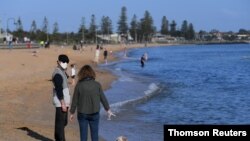Australia will allow more of its citizens stranded overseas by COVID-19 border controls to return home. The current weekly cap of 4,000 arrivals, who must go into mandatory hotel quarantine for 14 days, is to be increased by 1,500 by mid-October.
COVID-19 travel restrictions have left tens of thousands of Australians unable to fly home. Limits have been imposed on the number of citizens and permanent residents allowed to return because authorities do not want to overburden the quarantine system. All travelers returning from overseas must spend two weeks under guard in a hotel as part of efforts to curb the virus.
Under a new plan, announced by Prime Minister Scott Morrison late Friday,1,500 additional passengers will be allowed to come home by October 12. The plan was agreed to by the so-called national cabinet, made up of the prime minister, and state and territory premiers and chief ministers. The states of New South Wales, Western Australia and Queensland will all accept an additional 500 people per week. The number of arrivals will gradually climb in coming weeks despite federal authorities’ desire that they be increased much sooner.
Western Australian premier Mark McGowan, who was concerned over an earlier federal plan to double the state’s quota by September 28, said the system needs to be carefully managed.
“The decision by the federal government to unilaterally double Western Australia’s international arrivals by the 28th of September in our view carried too much risk for our state,” he said. “Today we secured a new way forward, a unique agreement for Western Australia, one that is more sensible and more workable.”
The pandemic has also brought fragmentation to the Australian federation of six states and two main territories. Many have closed their borders to Victoria, which is at the center of the nation’s coronavirus crisis, and neighboring New South Wales.
Authorities say the measures are needed to protect public health, but the federal government believes the restrictions are heavy-handed and are stifling the economy's recovery from the virus.
Tasmanian Premier Peter Gutwein says he is hoping to lift his island state’s restrictions earlier than a previously set deadline of December 1.
“The state controller, on the advice from public health, is looking at the possibility of bringing forward the date for easing our border restrictions with COVID-safe and low-risk states by the end of October, such as South Australia, WA [Western Australia] and the Northern Territory,” he said.
Officials are also working to set up a so-called “travel bubble” to allow flights to resume with New Zealand. Both countries have closed their borders to foreign nationals, although citizens and permanent residents can return.
COVID-19 was first diagnosed in Australia in late January. Almost 27,000 confirmed cases have been detected, and about 850 people have died. Most of the infections and fatalities have occurred in Victoria, although daily new case numbers are falling. The state capital, Melbourne, remains in lockdown for at least another week.









